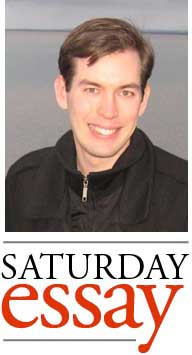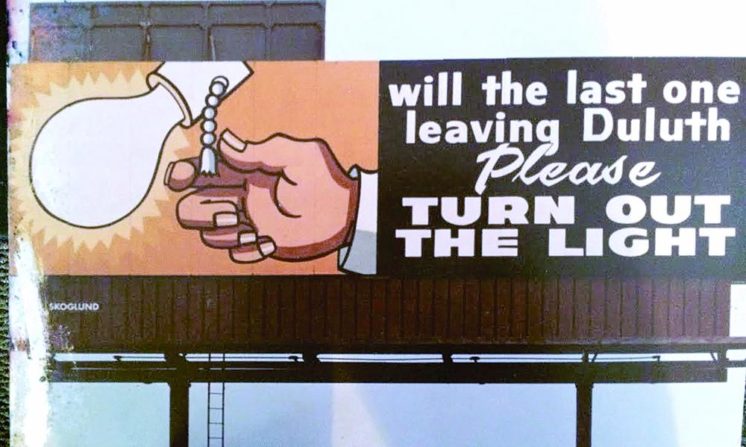Decline Porn, Duluth, and Love Amid the Ruins
 J.D. Vance, in a review of Janesville: An American Story in Commentary magazine:
J.D. Vance, in a review of Janesville: An American Story in Commentary magazine:
Having grown up in a blue-collar family that has largely abandoned the Democratic Party in droves, I have an unusually high tolerance for the many profiles of Trump voters in struggling industrial towns. Lately, however, even I have grown weary of what Noah Rothman calls “decline porn.” There are only so many words in the English language, and nearly all of them seem to have been used at least three times to help the denizens of Williamsburg and Dupont understand red-state voters and dying factory towns. Enough already.
Vance penned the most orgiastic piece of decline porn in recent memory, Hillbilly Elegy — apologies for my juvenile enjoyment of this metaphor — but there has been no shortage of titles in this genre, and a survey of my past reading list will find me devouring much of it, from Robert Putnam’s Our Kids to Yuval Levin’s The Fractured Republic, from George Packer’s The Unwinding to Charles Murray’s Coming Apart to Brian Alexander’s Glass House. It need not even be American; I could carry on with examples for a while. Decline porn is a fertile ground in contemporary non-fiction, and its best works tell haunting tales of realities that anyone vaguely involved in the shaping of political or economic trends must wrestle with. They also tap into a lament for things lost that speaks to a certain part of the human psyche and permeates my own writing at times. Someone who knows me well can probably psychoanalyze this wistfulness easily enough, but I come back to it for reasons that are philosophical as well as personal, and I could devote a lot of words to defending it in those terms. Meditations on loss go back to Eden and the early creation myths, as Paz so masterfully explains in the last chapter of The Labyrinth of Solitude. It’s a near universal human trait.
Despite this, I don’t consider myself a declinist. That golden past usually had its own ugly features, and nostalgia and selective memory whitewash the worst of it. Coping with change is also one of the greatest engines of human ingenuity and heroism, and if nothing else, it’s remarkably educational for those of us looking not to repeat past errors. If we fixate only on decline, we become depressing, tiresome people who are locked into a single lens and not much fun to talk to at parties.
Still, Vance likes Janesville. Despite the oversaturation of the genre — porn is everywhere these days, after all — its author, Amy Goldstein, gets to the heart of the flawed human stories, and instead of merely lamenting loss, looks to assess the responses to it. This one would likely strike home for me, too: my earliest memories are of the short stint my family spent living in a small town just north of Janesville, Wisconsin, and my mother worked there for a time. Unfortunately, Goldstein comes to fairly depressing conclusions. The basic tools of the trade in economic development, Janesville argues, have done little good to stem the tide of decline. Neither have worker retraining efforts, a rare point of bipartisan consensus on putting communities back to work. It adds up to a depressing summation of post-industrial America, with no obvious way forward for anyone.
Unless, of course, there might be any exceptions to the trend out there. I happen to be living in one.
Duluth, Minnesota is not heaven on earth. Its economy is not booming, its poverty rate is high, and there has been a rash of opioid overdoses, as in so much of the America exposed so ubiquitously in decline porn. But I will submit that it’s important to think about what it could have been, and that Duluth’s story is as much a triumph as any medium-sized Rust Belt town. In the early 1980s, its unemployment rate was second only to Youngstown, Ohio, which is not exactly great company to have. Population plummeted, manufacturing packed up and left, and a billboard asked the last person to leave to turn out the lights.
Most Rust Belt cities remain mired in the post-industrial swamp; the few that have broken free, like Pittsburgh, are the large ones that operate on a very different scale. And yet Duluth has charted a respectable course since it hit rock bottom in the ’80s. Unlike every other Rust Belt city, its population has been stable since 1990, instead of continued shrinkage. (See the table on this page for comparison cities.) The city is basically at full employment. Income growth around the greater Duluth area, while not on par with the booming coastal metros, does outpace the stagnant national average since 1990. The median income within the city itself, while not stellar ($40-some thousand), is a clear step above the Eries, Akrons, South Bends, and Scrantons of the world. The city’s image rehabilitation has been thorough, as it now comes off as an outdoorsy playground for Twin Cities residents on vacation. The Trump tide made little headway in the city proper (though precinct-level data challenges some aspects of the dominant media narrative, and suggests Trump was largely a rural and exurban phenomenon in Rust Belt states, not something that happened inside its former industrial engines). Sure, “we’re better than Flint!” isn’t exactly a winning slogan, but it’s important to understand what the odds were, and what could have been.
There are two ways to explain this.
The first is one of leadership and vision and a certain Duluthian exceptionalism, which us Duluthians would certainly like to believe. A lot of credit in this line of thinking goes to Don Ness, the young mayor who served from 2008-2016 and brought the city’s debt under control and led a massive rebranding effort. But he had some strong forerunners. At the height of the crisis in the ’80s, Duluth elected 29-year-old John Fedo. Unlike the consensus-driven and generally beloved Ness, Fedo was a warrior who wasn’t afraid to make enemies to push through his vision, but he also operated in a very different environment, and push through his vision he did. Fedo’s strategy was Keynesianism par excellence, with a junkyard reinvented as a tourist district and work crews set to work rebuilding streets for the sake of work and little else. Those efforts endure in obvious ways. His more market-oriented successor, Gary Doty, tried a lot of things to revive the economy, and while not all of them stuck, the general thrust was positive, as the city landed companies that are the cornerstones of the aviation and healthcare clusters that remain among its most promising foundations for sustained success. Beyond those three mayors, there’s the political influence of some clever longtime political operators who knew how to bring in the benefits like Jim Oberstar and Willard Munger, who were ahead of their time with ideas for building trail networks and capping freeways.
We can’t just credit the politicians, though. Duluth’s rehabilitation always had strong support from a loyal private sector, which continues to support changes through development and philanthropy. Pizza roll magnate Jeno Paulucci was a complicated figure with a complicated relationship with Fedo, but he did bankroll a lot of the changes in Canal Park. Several other big names in business left their mark, as did some of the legacy families whose early 20th century wealth continues to support local foundations and scholarships. That old money remains a boon to Duluth, as does a strong civic culture with its roots in Scandinavian immigration and a thriving arts scene that allows the city to punch far above its weight.
This, however, feeds into the other explanation, which has much more to do with structural factors than any brilliant maneuvering by the people in charge.
First off, geography has had its say. We call Duluth a Rust Belt city because it used to be a manufacturing center on the Great Lakes, and suffered the loss of that economic base and a drop in population comparable to other Rust Belt cities. But it’s isolated from the rest of them, and that may contain some spillover effects or a general sense that everything is going downhill. Instead, it sits in Minnesota, home to one of the wealthiest and most white collar metropolitan areas in the country in Minneapolis-St. Paul. As a regional center with a university and some hospitals, Duluth has some staying power that an Akron, just down the road from Cleveland, may not.
Local geography makes a difference, too. While Duluth isn’t overflowing with buildable land, it has had some pockets for new subdivisions that allowed for continued new home construction. Duluth has also proven somewhat resistant to the mass suburbanization of other Rust Belt cities; while there has certainly been growth beyond the city limits, it hasn’t come at major expense to the city’s tax base. A tour of the other Rust Belt cities will show that none of them has a Congdon: while some of the larger metro areas do have wealthy suburban neighbors, basically none of them have concentrations of wealth of any size within the city limits. (The only real exception, surprisingly, is Charleston, West Virginia, which benefits from the machinery of a state government that most Rust Belt cities lack.) For that matter, precious few Rust Belt cities have many Lakesides, Woodlands, or Piedmonts, those stable, comfortably middle class neighborhoods that allow for upward mobility and keep perceptions of public schools afloat. Many of these neighborhoods (and even little nice blocks that don’t show up in census tract data) are fairly isolated, strung out along Duluth’s 27 miles of ridgeline and separated by streams and parks. Even though they are older, they feel fairly suburban, and the park-like nature of the whole city just makes it more resistant to changes that might march smoothly down more cohesive urban grids. It has so many different little pockets, and that diversity begets resilience.
Speaking of diversity, Duluth has always been a very white city — yes, a 1920 lynching probably played a role in that — and the relative lack of racial dynamics make it distinct from a lot of Rust Belt cities that convulsed with conflict in the mid-20th century. White flight didn’t happen in Duluth on any meaningful scale, and while I wish I could claim this was due to some enlightened thinking on behalf of Duluthians, in reality there probably just weren’t enough people of color to set off that chain reaction. (Typically, this happens when the non-white population hits about 20 percent; Duluth remains over 90 percent white.) While the center of Duluth has hollowed out like basically every American city, Rust Belt or not, that probably had more to do with a declining old housing stock and poverty among white people. Other than perhaps some very recent school-driven outmigration, the growth in Duluth’s more suburban areas had much more to do with an abundance of buildable land and desire for space and newer homes than anything related to the people in Duluth itself. The city has been crawling toward greater diversity over recent decades, and if that trend continues or accelerates, Duluth’s response could well determine its future.
All of these factors are most likely intertwined in feedback loops, the causes impossible to separate from one another. There are few obvious lessons here, and some of Duluth’s strengths are accidents of geography in a city at the end of the line in the far north. But the relative successes are real, the leadership examples are real, and some of the things Duluth needs to do to remain an exemplar of Rust Belt success are clear, and cut across all such small cities. It needs to maintain its strong neighborhoods, keep its schools afloat, and prepare for an increasingly diverse future. Continued growth in diverse economic clusters will build a stronger safety net against future crashes. Concentration of poverty will only exacerbate divides and cut off pathways to eventual mobility. Duluth also needs to think on the level of a regional system, so that its future doesn’t devolve into squabbles between the city proper and the outlying areas. They’re all interconnected, part of one economy and one labor market, and their fates are intertwined.
As addicting as the decline porn may be, I’d much rather have an amorous adventure with something real, and with something that can learn from the past and grow into a future with me. It’s all right there before us.
Karl Schuettler is a Duluth native who recently meandered back to his hometown for a job in regional economic and community development. This post originally appeared on his blog, A Patient Cycle, where he spits out occasional thoughts on a perfectly logical combination of topics such as Duluth area affairs, the exploits of high school kids playing hockey, and anything else that wanders into his head.
Recommended Links:
Leave a Comment
Only registered members can post a comment , Login / Register Here















No Comments